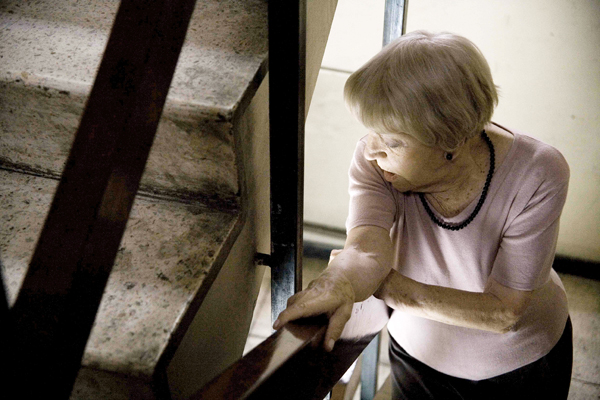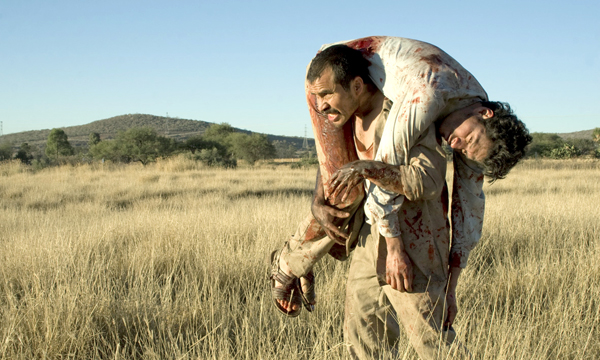|
Reviews of Recent Independent, Foreign, & Documentary Films in Theaters and DVD/Home Video

New York Film Festival 2010 The old, morbidly obese cats of the title waddle through the homey downtown Santiago apartment of venerable Isadora and Enrique, played by the real-life couple actress Bélgica Castro and playwright Enrique Alejandro Sievking. The forty-something daughter from Isadora’s first marriage, Rosario (Claudia Celedón), and her girlfriend Hugo have dropped in for tea to show off photos from their Peruvian vacation. It’s indicative of the mother and daughter’s prickly relationship that the allergenic—or psychosomatic—Rosario demands the cats be quarantined during her visit. It’s left unsaid that the critters enjoy much more unconditional attention than she ever did. Rosario and Hugo have also brought Peruvian “healing tablets,” or simply put, scented soap, central to Rosario’s latest career inspiration. She just needs an investment—never mind that her previous entrepreneurial efforts fizzled—namely, to have her mother sign over the apartment to her. To boost her courage, the disheveled Rosario retreats to the bathroom to snort some coke, a lot of it. The hand-held camera, zeroing in on the family’s foibles, is a tip of the hat to Cassavetes—a small-scale effort with huge emotions—and the sharp barbs and perfectly-timed deadpan reactions are not far off from Edward Albee. Co-directors/screenwriters Sebastián Silva and Pedro Peirano slyly capture the nuances of a family fight—you don’t know whether to laugh at Isadora’s caustic put-downs of her daughter or to feel embarrassed for Rosario. However, the most notable influence on the film, according to Peirano, is the Grand Guignol retread What Ever Happened to Baby Jane, at least in the psychological violence between mother and daughter and the increasingly claustrophobic atmosphere. (Don’t worry, no pets were harmed here.) Like Joan Crawford in Baby Jane, Isadora is physically trapped. The building’s elevator is out of commission, and with her bad hip, she can’t navigate the 10 flights of stairs. A sequence of Isadora slowly managing her way down the stairwell is as suspenseful as anything in that old B-movie favorite. The only out-of-tune note is the performance of Catalina Saavedra (from Sebastián Silva’s The Maid). Originally the role of Hugo was male, but Silva wanted to work with Saavedra again and so modified the part accordingly. The peacemaker by default, Hugo has more insight and compassion than anyone else in the film—even when she’s high as a kite—but the heavy-handed mannerisms incongruously stand out. As a butch dyke, Saavedra tries too hard, in contrast to the effortlessness of the rest of the ensemble. Meanwhile, the 92-year-old Castro effortlessly transitions from lucidity to the early stages of dementia. Kent Turner The following NYFF films have made the rounds of other major festivals, including the up-and-coming London Film Festival; like NYFF, it has a slender offering of world premieres. Yet since the festival concluded, only one (Meek’s Cutoff) has hooked up with a distributor.
Fernando Eimbcke’s opener proves his humor to be as dry as ever, with his typically lengthy master shot setups largely missing. Patricia Riggen directs a heartwarming comedy about a woman who returns her embalmed father’s body to Mexico for a traditional burial, the resolution of which will stay with you for a while. The ending of Amat Escalante’s effort—about the unlikely providence of a fast-food restaurant for a starving pair of orphaned children and their Jesuit priest traveling companion—will likewise leave you speechless. Escalante’s deliberate similarities vary from the Mexican classic El Topo to Kurosawa to Albert Serra’s Birdsong. Carlos Reygadas directs the most unique of the collection, a raucous real-life party scene that features someone from just about every socio-economic stratum, culminating in the ritual burning of a beat-up sedan in the backyard. Also of note are the films by Diego Luna and Rodrigo Plá, but far and away the best and most surprising is that of actor Gael García Bernal. It’s a very cool story about a boy whose visiting cousin blows his mind when he declares, “I don’t believe in images,” and confidently describes his own personal spirituality, outside of the church and its rituals, at the risk of a spanking from his abuelita. The photography is excellent, and, in particular, Bernal’s attention to camera placement is impressive. Watch for the final shot of the sun revealed over the hazy horizon while a triumphant brass orchestra resounds. If Revolución can’t stir you, I don’t know what can. Meek’s Cutoff is the kind of film where one could spend most of the first half just deciding on what kind of film it is. Luckily, Kelly Reichardt’s characteristic snail’s pace allows for it. I suppose it’s a revisionist Western, but you could put that label on any work that looks at old conventions in a new way. Colloquialisms like “Hell’s full of Indians,” rich details like the deliberate squeak of a wagon wheel, and the region specific photography of big skies and hazy moons prove her dedication to the genre, but Reichardt looks at old ideas in new ways as well. It’s more like a revisionist revisionist film. Discerning the power dynamic within a doomed 1845 wagon train is essential to understanding the story. In fact, the cliffhanger ending leaves us with little else to consider. The party’s salty guide (Bruce Greenwood) proves to be incompetent, the second-in-command’s wife (Michelle Williams) begins to call the shots, and a potentially hostile Plains Indian guide (Rod Rondeaux) becomes their only hope for survival. The question facing the party: whether to follow the Indian to what could either be drinking water or an awaiting hostile tribe, or to kill him immediately at the risk of never finding water in time. Reichardt neatly dramatizes the prisoner’s dilemma, that famed moral puzzle, and the real question she poses is whether this party’s decisions are made out of logic or out of morality, and what exactly is the difference. Michael Lee In the intimate historical epic Mysteries of Lisbon, director Raúl Ruiz again takes on the challenge of adapting 19th century literature, here the novel by Camilo Castelo Branco, a popular 1854 classic of Portuguese literature that has never been translated into English. Written serially for publication, like Charles Dickens’ novels, the original’s format of amazingly interconnected characters is marvelously suited to a structure of flashbacks within flashbacks sparked by Proustian memories, just as in Ruiz’s 1999 cinematic take of Time Regained. The story opens with an orphan boy, 14-year-old João, who’s ashamed of having no last name, and chronicles the continuing revelations about his family, birth, enemies, rescuers, and then his own infatuations and losses as he grows up. The loves and jealousies are like Balzac, and the historical sweep is of Victor Hugo, crossing continents during the time when the European aristocracy was shaken by Napoleon. (A Brazilian pirate-turned-ubiquitous war profiteer is particularly memorable.) Fortunes are protected and rejected, beautiful young lovers are discovered by furious fathers, illegitimate children abound, jealous husbands are brutal, spurned women are vengeful, and priests and nuns retreat to the church in penance and grief. Servants, ever watchful, listen in on these aristocratic families as the audience’s entrée into the stunning period settings. The New York Film Festival screened the film in its 272-minute theatrical version, shortened from what Ruiz intends as a 330-minute, six-part television mini-series. As ambitious European TV productions such as this one rarely make it to the U.S. uncut, the truncated version may be all Americans get to see. (Olivier Assayas’s Carlos, also at the Festival, is a notable exception, showing on the Sundance Channel.) When Ruiz took ill last year, his producer and editor followed his instructions to cut out whole story lines, but that may have contributed to some confusion in the tangled romantic quadrangles towards the end. Regardless, André Szankowski’s cinematography is worth seeing on a big screen. Foreign Parts’ co-director, Véréna Paravel, is a French visual anthropologist and protégé of Lucien Castaing-Taylor at the Harvard University Sensory Ethnography Lab, whose Sweetgrass, in last year’s festival, followed a sheep drive in Montana. At the opposite end of the country, Paravel journeys on New York City’s #7 elevated subway train to the Willet’s Point stop in Queens to explore junkyards full of salvaged auto parts and car repair hustlers. The neighborhood’s so-called “Iron Triangle” was the locale two years ago for Ramin Bahrani’s fictional Chop Shop, set among the gritty businesses on the wrong side of the street from the Mets’ stadium. Paravel and her co-director J. P. Sniadecki capture the rhythms, sounds, and images of the district (near where I live) from the early start of the business day to the baseball cheers wafting over quiet nights. In the industry that drives the area, cars get broken down into their components—tires, mirrors, glass, doors—that are stored and sold, the detritus of the automobile culture organized and labeled for reuse.
The seemingly endless array of auto parts is beautifully
photographed like a Bauhaus citadel of industrial design, but the
broken-down vehicles are a bit heavy-handedly paralleled with some of
the damaged people the filmmakers find among the workers and hangers-on,
who showboat for too long on camera. More emblematic of the endurance of
the besieged neighborhood are the go-getters, who efficiently keep the
line of cars moving through the chop shops, and the hard-working
immigrants, who bemoan being mired in grease but are uneasy about losing
their jobs to the planned redevelopment of the area. At least the determined pair of Lubavitcher
Hasidic
missionaries who trudge through the puddles to recruit
Israeli workers are optimistic that a savior will rise from these dirty
streets. Nora Lee Mandel
|


